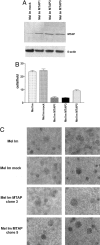Characterization of methylthioadenosin phosphorylase (MTAP) expression in malignant melanoma
- PMID: 12875987
- PMCID: PMC1868213
- DOI: 10.1016/S0002-9440(10)63695-4
Characterization of methylthioadenosin phosphorylase (MTAP) expression in malignant melanoma
Abstract
Homozygous deletions of human chromosomal region 9p21 occur frequently in malignant melanoma and are associated with the loss of the tumor suppressor genes p16(INK4a) and p15(INK4b). In the same chromosomal region the methylthioadenosine phosphorylase (MTAP) gene is localized and therefore may also serve as a tumor suppressor gene. The aim of this study was to analyze MTAP mutations and expression patterns in malignant melanomas. To examine the MTAP gene and expression of MTAP protein we screened 9 human melanoma cell lines and primary human melanocytes by reverse transcriptase-polymerase chain reaction, sequencing, and immunoblotting. Analyzing the melanoma cell lines we found significant down-regulation of MTAP mRNA expression. In only one cell line, HTZ19d, this was due to homozygous deletion of exon 2 to 8 whereas in the other cell lines promoter hypermethylation was detected. MTAP expression was further analyzed in vivo by immunohistochemical staining of 38 tissue samples of benign melanocytic nevi, melanomas, and melanoma metastases. In summary, we demonstrate significant inverse correlation between MTAP protein expression and progression of melanocytic tumors as the amount of MTAP protein staining decreases from benign melanocytic nevi to metastatic melanomas. Our results suggest an important role of MTAP inactivation in the development of melanomas. This finding may be of great clinical significance because recently an association between MTAP activity and interferon sensitivity has been suggested.
Figures






References
-
- Mowen KA, Tang J, Zhu W, Schurter BT, Shuai K, Herschman HR, David M: Arginine methylation of STAT1 modulates IFNα/β-induced transcription. Cell 2001, 104:731-741 - PubMed
-
- Christopher SA, Diegelman P, Porter CW, Kruger WD: Methylthioadenosine phosphorylase, a gene frequently codeleted with p16(cdkN2a/ARF), acts as a tumor suppressor in a breast cancer cell line. Cancer Res 2002, 62:6639-6644 - PubMed
-
- Garcia-Castellano JM, Villanueva A, Healey JH, Sowers R, Cordon-Cardo C, Huvos A, Bertino JR, Meyers P, Gorlick R: Methylthioadenosine phosphorylase gene deletions are common in osteosarcoma. Clin Cancer Res 2002, 8:782-787 - PubMed
-
- Wong YF, Chung TK, Cheung TH, Nobori T, Chang AM: MTAP gene deletion in endometrial cancer. Gynecol Obstet Invest 1998, 45:272-276 - PubMed
-
- Hori Y, Hori H, Yamada Y, Carrera CJ, Tomonaga M, Kamihira S, Carson DA, Nobori T: The methylthioadenosine phosphorylase gene is frequently co-deleted with the p16INK4a gene in acute type adult T-cell leukemia. Int J Cancer 1998, 75:51-56 - PubMed
Publication types
MeSH terms
Substances
LinkOut - more resources
Full Text Sources
Other Literature Sources
Medical

